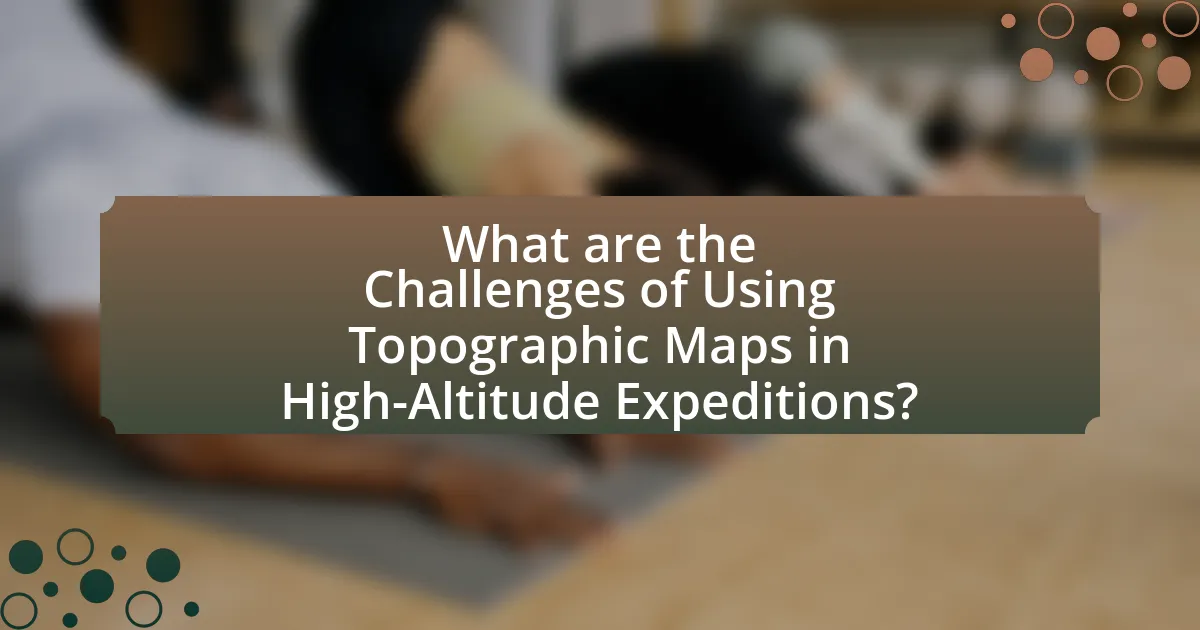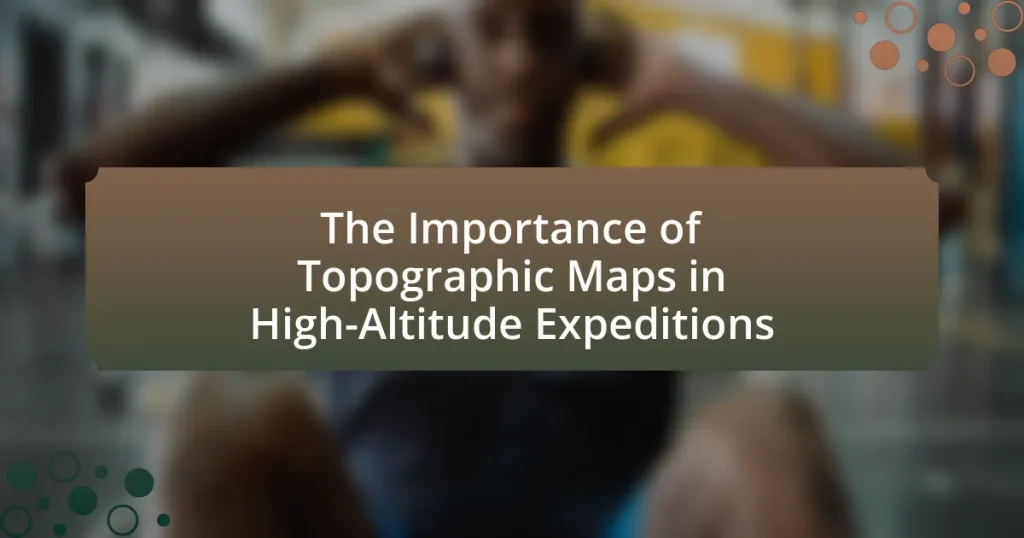Topographic maps are essential tools for high-altitude expeditions, providing detailed representations of terrain, elevation changes, and geographic features through contour lines. These maps facilitate accurate navigation and route planning, helping climbers and trekkers identify hazards and make informed decisions in challenging environments. The article explores the differences between topographic maps and other map types, the features they represent, and the skills necessary for effective use. It also addresses the challenges adventurers face when using these maps, the role of technology in enhancing navigation, and best practices for preparation and on-the-ground navigation during expeditions.

What are Topographic Maps and Why are They Important for High-Altitude Expeditions?
Topographic maps are detailed representations of terrain that illustrate elevation, landforms, and geographic features using contour lines. These maps are crucial for high-altitude expeditions because they provide essential information about the landscape, including the steepness of slopes, the location of ridges and valleys, and potential hazards such as cliffs or crevasses. Accurate navigation and route planning are vital in high-altitude environments, where conditions can change rapidly and visibility may be limited. The use of topographic maps allows climbers and trekkers to make informed decisions, enhancing safety and efficiency during their expeditions.
How do Topographic Maps differ from other types of maps?
Topographic maps differ from other types of maps by providing detailed representations of terrain, including elevation changes, landforms, and contours. Unlike general maps that may focus on political boundaries or road networks, topographic maps use contour lines to indicate elevation, allowing users to visualize the steepness and shape of the landscape. This specificity is crucial for activities such as hiking, climbing, and other high-altitude expeditions, where understanding the terrain is essential for navigation and safety.
What features are represented on a topographic map?
Topographic maps represent various physical features of the terrain, including elevation, landforms, bodies of water, vegetation, and human-made structures. Elevation is depicted through contour lines, which connect points of equal height, allowing users to visualize the steepness and shape of the landscape. Landforms such as mountains, valleys, and hills are illustrated through these contour lines, while water features like rivers, lakes, and ponds are marked with blue shading or symbols. Vegetation types may be indicated through color coding, and human-made structures such as roads, trails, and buildings are represented with specific symbols. These features provide essential information for navigation and planning in high-altitude expeditions, ensuring safety and efficiency.
How do contour lines convey elevation and terrain information?
Contour lines represent elevation and terrain information by connecting points of equal elevation on a map. These lines indicate the steepness of slopes; closely spaced lines signify steep terrain, while widely spaced lines indicate gentle slopes. The elevation difference between contour lines, known as contour interval, provides specific height information, allowing users to understand the vertical landscape. For example, a contour interval of 10 meters means that each line represents a 10-meter change in elevation. This systematic representation enables hikers and climbers to assess the difficulty of a route and navigate effectively in high-altitude environments.
Why are Topographic Maps essential for navigation in high-altitude environments?
Topographic maps are essential for navigation in high-altitude environments because they provide detailed representations of terrain features, including elevation changes, slopes, and landforms. These maps enable climbers and hikers to understand the landscape, identify potential hazards such as cliffs or crevasses, and plan safe routes. The accuracy of topographic maps, often derived from surveys and satellite data, ensures that users can make informed decisions about their paths, which is critical in challenging high-altitude conditions where visibility may be limited and terrain can be treacherous.
How do they assist in route planning and decision-making?
Topographic maps assist in route planning and decision-making by providing detailed representations of terrain features, elevation changes, and potential hazards. These maps enable expedition planners to identify the most efficient and safe routes, considering factors such as slope steepness, water sources, and obstacles like cliffs or glaciers. For instance, a study published in the Journal of Outdoor Recreation and Tourism highlights that accurate elevation data from topographic maps can significantly reduce the risk of navigational errors in high-altitude environments, thereby enhancing safety and efficiency during expeditions.
What risks can be mitigated by using topographic maps during expeditions?
Using topographic maps during expeditions can mitigate risks such as navigation errors, unexpected terrain challenges, and altitude sickness. Topographic maps provide detailed information about elevation changes, landforms, and potential hazards, enabling expedition leaders to plan routes that avoid steep cliffs, unstable ground, or areas prone to avalanches. For instance, a study by the American Alpine Club highlights that accurate navigation reduces the likelihood of getting lost, which is crucial in high-altitude environments where conditions can change rapidly. Additionally, understanding elevation profiles helps in acclimatization strategies, thereby reducing the risk of altitude sickness among climbers.
What skills are necessary to effectively use Topographic Maps?
To effectively use topographic maps, individuals need skills in map reading, spatial awareness, and terrain interpretation. Map reading involves understanding symbols, scales, and contour lines, which are essential for navigating and assessing elevation changes. Spatial awareness allows users to visualize the relationship between the map and the physical landscape, aiding in route planning and decision-making. Terrain interpretation skills enable individuals to analyze features such as slopes, valleys, and water bodies, which are crucial for safe navigation in high-altitude environments. Mastery of these skills enhances the ability to utilize topographic maps effectively during expeditions.
How can one learn to read and interpret topographic maps?
To learn to read and interpret topographic maps, one should start by familiarizing themselves with the map’s symbols, contour lines, and scale. Understanding contour lines, which represent elevation changes, is crucial; closely spaced lines indicate steep terrain, while widely spaced lines suggest gentle slopes. Additionally, learning to identify key features such as hills, valleys, and water bodies on the map enhances interpretation skills. Practical experience, such as using topographic maps during hikes or outdoor activities, reinforces these skills. Resources like online tutorials, guidebooks, and courses on map reading can provide structured learning and practice opportunities.
What tools complement the use of topographic maps in high-altitude expeditions?
GPS devices complement the use of topographic maps in high-altitude expeditions by providing real-time location data and navigation assistance. These devices enhance the accuracy of positioning, allowing climbers to track their route and make informed decisions based on their current location relative to the terrain depicted on the map. Additionally, altimeters are crucial tools that measure elevation changes, helping adventurers understand their altitude in relation to the topographic features. Together, GPS devices and altimeters improve safety and navigation efficiency in challenging high-altitude environments.

What are the Challenges of Using Topographic Maps in High-Altitude Expeditions?
The challenges of using topographic maps in high-altitude expeditions include difficulties in scale interpretation, terrain distortion, and environmental factors affecting visibility. High-altitude regions often have steep gradients and complex terrain that can make it hard to accurately interpret the scale of features on a map. Additionally, atmospheric conditions such as fog, snow, or rain can obscure visibility, making it challenging to correlate the map with the actual landscape. Furthermore, the physical exertion and altitude sickness experienced by climbers can impair cognitive functions, complicating navigation and map reading. These factors collectively hinder the effective use of topographic maps in high-altitude settings.
What common mistakes do adventurers make when using topographic maps?
Adventurers commonly make mistakes such as misinterpreting contour lines, neglecting to account for scale, and failing to update their maps. Misinterpreting contour lines can lead to incorrect assessments of terrain steepness, which is critical for navigation and safety. Neglecting to account for scale results in inaccurate distance estimations, potentially leading to underestimating travel time and energy expenditure. Failing to update maps can cause adventurers to rely on outdated information, which may not reflect recent changes in the landscape, such as new trails or hazards. These mistakes can significantly impact the success and safety of high-altitude expeditions.
How can misinterpretation of map features lead to dangerous situations?
Misinterpretation of map features can lead to dangerous situations by causing navigational errors that result in exposure to hazardous terrain or conditions. For instance, if a climber misreads contour lines on a topographic map, they may underestimate the steepness of a slope, leading to falls or accidents. Additionally, misunderstanding symbols for water sources or trails can result in dehydration or getting lost in remote areas. Historical incidents, such as the 1996 Mount Everest disaster, illustrate how incorrect interpretations of maps contributed to fatal decisions, emphasizing the critical need for accurate map reading in high-altitude expeditions.
What environmental factors can affect the accuracy of topographic maps?
Environmental factors that can affect the accuracy of topographic maps include vegetation cover, weather conditions, and geological changes. Dense vegetation can obscure ground features, leading to inaccuracies in elevation and terrain representation. Weather conditions, such as fog or heavy precipitation, can hinder visibility and affect the ability to accurately survey land. Geological changes, including erosion or landslides, can alter the landscape over time, making previously accurate maps outdated. These factors collectively contribute to discrepancies between the actual terrain and its representation on topographic maps.
How can technology enhance the use of Topographic Maps in expeditions?
Technology enhances the use of topographic maps in expeditions by integrating GPS and mobile applications, which provide real-time location tracking and navigation. These advancements allow expedition teams to overlay their current position on digital topographic maps, improving route planning and decision-making. For instance, GPS devices can pinpoint exact coordinates, enabling users to identify terrain features and elevation changes accurately, which is crucial in high-altitude environments where conditions can change rapidly. Additionally, mobile applications often include features such as offline map access and weather updates, further supporting expeditions in remote areas.
What role do GPS devices play in conjunction with topographic maps?
GPS devices enhance the usability of topographic maps by providing real-time location data, which aids in navigation and route planning during high-altitude expeditions. When combined, GPS devices allow users to pinpoint their exact location on a topographic map, facilitating better decision-making regarding terrain features, elevation changes, and potential hazards. Studies have shown that the integration of GPS technology with topographic maps significantly reduces the risk of getting lost in challenging environments, as users can cross-reference their GPS coordinates with map details to ensure accurate navigation.
How can mobile applications improve navigation in high-altitude areas?
Mobile applications can improve navigation in high-altitude areas by providing real-time GPS tracking and detailed topographic maps. These applications utilize satellite data to offer accurate positioning, which is crucial in environments where traditional navigation methods may fail due to challenging terrain and weather conditions. For instance, apps like Gaia GPS and AllTrails allow users to download offline maps, ensuring access to critical navigation information even in areas with limited connectivity. Additionally, features such as waypoint marking and route planning enhance the user’s ability to navigate complex landscapes, reducing the risk of getting lost. Studies have shown that the integration of mobile technology in outdoor navigation significantly increases safety and efficiency, particularly in remote and high-altitude environments.

What Best Practices Should Be Followed When Using Topographic Maps for High-Altitude Expeditions?
When using topographic maps for high-altitude expeditions, it is essential to ensure accurate navigation and safety. First, familiarize yourself with the map’s symbols and contour lines to understand elevation changes and terrain features. This knowledge helps in planning routes that avoid hazards such as steep cliffs or unstable ground. Second, always carry a compass and use it in conjunction with the map to maintain orientation, especially in areas where visibility may be limited. Third, regularly check your position against the map to confirm your route and make adjustments as necessary. Additionally, consider the scale of the map; a larger scale provides more detail, which is crucial for navigating complex terrains. Lastly, practice using the map in a controlled environment before the expedition to build confidence and proficiency. These practices enhance safety and effectiveness during high-altitude expeditions, as evidenced by successful navigation in challenging environments documented in outdoor survival literature.
What preparation steps are essential before an expedition?
Essential preparation steps before an expedition include thorough research, physical training, and acquiring necessary gear. Research involves understanding the terrain, weather conditions, and potential hazards, which is crucial for safety and navigation. Physical training enhances endurance and strength, preparing individuals for the physical demands of the expedition. Acquiring necessary gear, such as topographic maps, ensures that explorers can navigate effectively and respond to environmental challenges. According to the American Alpine Club, proper preparation significantly reduces risks associated with high-altitude expeditions, emphasizing the importance of these steps.
How can one create a comprehensive route plan using topographic maps?
To create a comprehensive route plan using topographic maps, one must analyze the elevation contours, terrain features, and landmarks depicted on the maps. This involves identifying the starting point and destination, assessing the elevation changes along the route, and selecting paths that minimize steep ascents or descents. Topographic maps provide critical information such as slope gradients, water sources, and potential hazards, which are essential for planning a safe and efficient route. For instance, a study by the American Alpine Club highlights that understanding contour lines can significantly improve navigation and decision-making in mountainous terrains, thereby enhancing expedition safety and success.
What should be included in a pre-expedition briefing for team members?
A pre-expedition briefing for team members should include an overview of the expedition objectives, safety protocols, roles and responsibilities, communication plans, and a detailed review of topographic maps. The overview of objectives clarifies the mission and expected outcomes, while safety protocols ensure that all team members understand emergency procedures and risk management strategies. Clearly defined roles and responsibilities help in task allocation and accountability during the expedition. The communication plan outlines how team members will stay in contact, especially in remote areas, and the review of topographic maps is crucial for navigation and understanding the terrain, which is essential in high-altitude expeditions where conditions can change rapidly.
What are some tips for effective on-the-ground navigation using topographic maps?
To navigate effectively on the ground using topographic maps, familiarize yourself with the map’s symbols and contour lines, as they represent elevation changes and terrain features. Understanding these elements allows for better route planning and hazard identification. Additionally, always orient the map to your surroundings using a compass or landmarks, ensuring that the map’s north aligns with true north. This practice enhances spatial awareness and reduces the risk of getting lost. Regularly check your position against the map by identifying prominent features, which helps confirm your route and adjust as necessary. These techniques are essential for successful navigation in high-altitude environments, where terrain can be challenging and visibility may be limited.
How can one maintain situational awareness while navigating?
To maintain situational awareness while navigating, one should continuously assess their surroundings and utilize topographic maps effectively. This involves regularly checking the map for terrain features, elevation changes, and potential hazards, which helps in understanding the current position relative to the environment. Studies show that effective map reading enhances spatial awareness, allowing navigators to anticipate challenges and make informed decisions. For instance, a study published in the Journal of Navigation highlights that individuals who actively engage with topographic maps demonstrate improved situational awareness and decision-making skills in complex terrains.
What strategies can help in adapting to unexpected changes in terrain?
To adapt to unexpected changes in terrain, individuals should employ strategies such as maintaining situational awareness, utilizing topographic maps, and adjusting their route based on real-time observations. Situational awareness allows for quick assessment of the environment, enabling hikers or climbers to identify hazards or opportunities for safer paths. Topographic maps provide critical information about elevation changes, landforms, and potential obstacles, which can guide decision-making during unexpected terrain shifts. Additionally, adjusting routes based on real-time observations ensures that individuals can navigate around obstacles or difficult areas effectively, enhancing safety and efficiency during high-altitude expeditions.
What resources are available for further learning about Topographic Maps?
Resources available for further learning about topographic maps include online courses, textbooks, and government publications. Online platforms like Coursera and Udemy offer courses specifically focused on map reading and interpretation. Textbooks such as “Topographic Maps: A Guide for Beginners” provide foundational knowledge and practical applications. Additionally, government agencies like the United States Geological Survey (USGS) publish detailed guides and resources on understanding and using topographic maps, which are essential for high-altitude expeditions. These resources collectively enhance comprehension and practical skills related to topographic maps.
Where can one find online courses or workshops on map reading?
One can find online courses or workshops on map reading through platforms such as Coursera, Udemy, and the National Outdoor Leadership School (NOLS). These platforms offer structured courses that cover various aspects of map reading, including topographic maps, which are essential for high-altitude expeditions. For instance, Coursera features courses from universities that focus on navigation skills, while Udemy provides practical workshops tailored for outdoor enthusiasts. NOLS specifically offers courses that emphasize the importance of map reading in wilderness settings, reinforcing the skills necessary for safe navigation in challenging terrains.
What books or guides are recommended for mastering topographic navigation?
“Navigation with a Map and Compass” by Bob Burns and Mike Burns is highly recommended for mastering topographic navigation. This book provides comprehensive guidance on using maps and compasses effectively, emphasizing practical skills essential for outdoor navigation. Additionally, “The Ultimate Hiker’s Gear Guide” by Andrew Skurka includes sections on navigation techniques and the importance of topographic maps in planning high-altitude expeditions. Both resources are well-regarded in the outdoor community for their clarity and practical advice, making them valuable for anyone looking to enhance their navigation skills.
